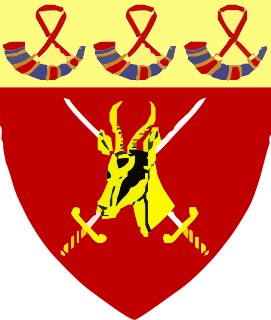
The 4th Indian Infantry Division, also known as the Red Eagle Division, is an infantry division of the Indian Army. This division of the British Indian Army was formed in Egypt in 1939 during the Second World War. During the Second World War, it took part in campaigns in East Africa, Syria, North Africa and Italy. Post independence, the division is part of the I Corps and headquartered at Prayagraj.
The 1st South African Infantry Division was an infantry division of the army of the Union of South Africa. During World War II the division served in East Africa from 1940 to 1941 and in the Western Desert Campaign from 1941 to 1942. The division was disbanded on 1 January 1943, for conversion into what would become the 6th South African Armoured Division. The division was also briefly active after the war from 1 July 1948 to 1 November 1949.
The South African 2nd Infantry Division was an infantry division of the army of the Union of South Africa during World War II. The division was formed on 23 October 1940 and served in the Western Desert Campaign and was captured by German and Italian forces at Tobruk on 21 June 1942. The remaining brigade was re-allocated to the South African 1st Infantry Division.

The South African 3rd Infantry Division was an infantry division of the South African Army during World War II.

The Rifle Brigade was an infantry rifle regiment of the British Army formed in January 1800 as the "Experimental Corps of Riflemen" to provide sharpshooters, scouts, and skirmishers. They were soon renamed the "Rifle Corps". In January 1803, they became an established regular regiment and were titled the 95th Regiment of Foot (Rifles). In 1816, at the end of the Napoleonic Wars, they were again renamed, this time as the "Rifle Brigade".
The Rifles is an infantry regiment of the British Army. Formed in 2007, it consists of four Regular battalions and three Reserve battalions, plus a number of companies in other Army Reserve battalions. Each battalion of The Rifles was formerly an individual battalion of one of the two large regiments of the Light Division. Since formation the regiment has been involved in combat operations, first in the later stages of the Iraq War and in the War in Afghanistan.

The 5th Indian Infantry Division was an infantry division of the Indian Army during World War II that fought in several theatres of war and was nicknamed the "Ball of Fire". It was one of the few Allied divisions to fight against three different armies - the Italian, German and Japanese armies.

The Cameronians was a rifle regiment of the British Army, the only regiment of rifles amongst the Scottish regiments of infantry. It was formed in 1881 under the Childers Reforms by the amalgamation of the 26th Cameronian Regiment and the 90th Perthshire Light Infantry. In 1968, when reductions were required, the regiment chose to be disbanded rather than amalgamated with another regiment, one of only two infantry regiments in the British Army to do so, with the other being the York and Lancaster Regiment. It can trace its roots to that of the Cameronians, later the 26th of Foot, who were raised in 1689. The 1881 amalgamation coincided with the Cameronian's selection to become the new Scottish Rifles.

The Andrew Mlangeni Regiment is a reserve infantry regiment of the South African Army.

The Umvoti Mounted Rifles is an armoured regiment of the South African Army. As a reserve unit, it has a status roughly equivalent to that of a British Army Reserve or United States Army National Guard unit. It is part of the South African Army Armour Formation and is based in the town of Pinetown.

The 23rd Infantry Brigade was an infantry brigade of the British Army that saw active service in the First World War, mainly on the Western Front During the Second World War, the brigade saw active service in the Syria-Lebanon Campaign, the Western Desert Campaign, and the Burma Campaign.
The 150th Infantry Brigade was an infantry formation of the British Army that saw active service in the Second World War. A 1st Line Territorial Army brigade, it was part of the 50th (Northumbrian) Infantry Division. It served in the Battle of France and was evacuated from Dunkirk. Later it served in the Middle East and was overrun and forced to surrender during the Battle of Gazala in the North African Campaign. For almost 72 hours during the battle the 150th Brigade and the 44th Royal Tank Regiment held out against Erwin Rommel's concentrated attacks, without any support. On 1 June the German Army finally forced their surrender. The brigade was not reformed.

The 1st Free French Division was one of the principal units of the Free French Forces (FFL) during World War II, renowned for having fought the Battle of Bir Hakeim.
The South African 1st Infantry Brigade was an infantry brigade of the army of the Union of South Africa during World Wars I and II. During World War I, the Brigade served as a British formation in Egypt and on the Western Front, most famously the Battle of Delville Wood. It was reactivated at the start of the Second World War as a South African formation and served in East Africa and the Western Desert; the Brigade disbanded on 1 January 1943.
The 2nd South African Infantry Brigade was an infantry brigade of the army of the Union of South Africa during World War II. The Brigade formed part of the South African 1st Infantry Division and was formed on 13 August 1940. It served in East Africa and the Western Desert and was disbanded on 1 January 1943.
The 5th South African Infantry Brigade was an infantry brigade of the army of the Union of South Africa during World War II. The Brigade formed part of the South African 1st Infantry Division and was formed on 13 August 1940. It served in East Africa and the Western Desert and was disbanded on 1 January 1943.
The 25th Indian Infantry Brigade was an infantry brigade formation of the Indian Army during World War II. It was formed in February, 1941 at Ahmednagar in India and assigned to the 10th Indian Infantry Division. The brigade was attached to the 8th Indian Infantry Division in August 1941, and took part in the Anglo-Soviet invasion of Iran. Returning to the 10th Indian Division in August 1941, they arrived in the desert just in time for the Battle of Gazala and continued to fight in the Western Desert Campaign and later in the Italian Campaign. While in Italy the brigade was attached to the British 46th Infantry Division from 7 to 11 December 1944.

Orange Free State Command was a command of the South African Army, active from c. 1933 to c. 1999. Its headquarters was at Bloemfontein, seemingly for a period at the Tempe airfield, later to become the Tempe Military Base.
This page details the South African Army order of battle in 1940, before and after the formation of expeditionary forces.

2nd South African Infantry Regiment was an infantry regiment of the South African Overseas Expeditionary Force during the First World War.










